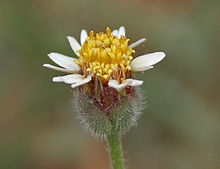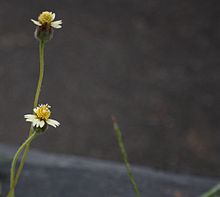- Tridax procumbens
-
Tridax procumbens 
Scientific classification Kingdom: Plantae (unranked): Angiosperms (unranked): Eudicots (unranked): Asterids Order: Asterales Family: Asteraceae Tribe: Heliantheae Genus: Tridax Species: T. procumbens Binomial name Tridax procumbens
L.Tridax procumbens is a species of flowering plant in the daisy family. It is best known as a widespread weed and pest plant. It is native to the tropical Americas but it has been introduced to tropical, subtropical, and mild temperate regions worldwide. It is listed as a noxious weed in the United States and has pest status in nine states.[1]
Contents
Description
The plant bears daisylike yellow-centered white or yellow flowers with three-toothed ray florets. The leaves are toothed and generally arrowhead-shaped. Its fruit is a hard achene covered with stiff hairs and having a feathery, plumelike white pappus at one end.Calyx is represented by scales or reduced to pappus The plant is invasive in part because it produces so many of these achenes, up to 1500 per plant, and each achene can catch the wind in its pappus and be carried some distance. This weed can be found in fields, meadows, croplands, disturbed areas, lawns, and roadsides in areas with tropical or semi-tropical climates.
Human uses
Tridax procumbens is known for several potential therapeutic activities like antiviral, antibiotic efficacies, wound healing activity, insecticidal and anti-inflammatory activity.[2] Some reports from tribal areas in India state that the leaf juice can be used to cure fresh wounds, to stop bleeding, as a hair tonic.
Common Names
Its common names include coat buttons and tridax daisy in English, cadillo chisaca in Spanish, herbe caille in French, Jayanti veda in Sanskrit, ghamra in Hindi, Bishalya karani in Oriya, Kambarmodi in Marathi, Gaddi Chemanthi (గడ్డి చామంతి) in Telugu,Thata poodu in Tamil[3], and kotobukigiku in Japanese.
Gallery
-
Crimson Tip Colotis danae in Hyderabad, India. Coat buttons is widely visited by butterflies.
References
- ^ ""Tridax procumbens L.".". Encyclopedia of Life. http://www.eol.org/pages/503264. Retrieved 26 April 2010.
- ^ Suseela, L.; Sarsvathy, A.; Brindha, P. (2002). "Pharmacognostic studies on Tridax procumbens L.(Asteraceae)". Journal of Phytological Research 15 (2): 141–147.
- ^ Saxena, V. K. & S. Albert. (2005). β-Sitosterol-3-O-β-D-xylopyranoside from the flowers of Tridax procumbens Linn. J Chem Sci 117:3 263-266.
Further reading
Everitt, J.H.; Lonard, R.L., Little, C.R. (2007). Weeds in South Texas and Northern Mexico. Lubbock: Texas Tech University Press. ISBN 0-89672-614-2
External links
Categories:- Asteraceae
- Invasive plant species
Wikimedia Foundation. 2010.





